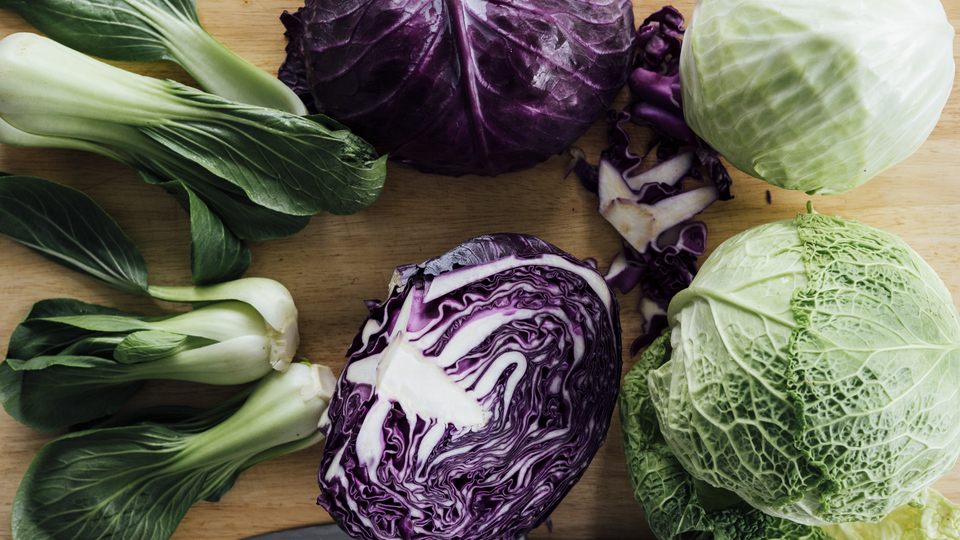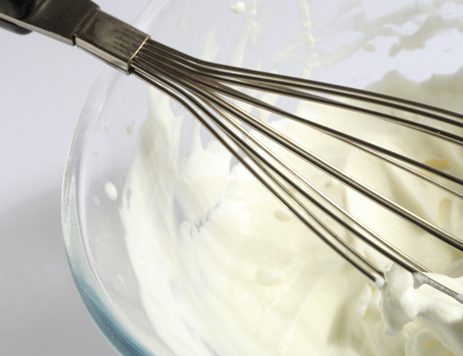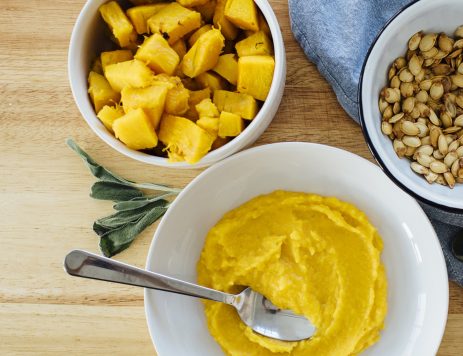
Cabbage 101: Different Types and How to Cook and Enjoy Cabbage
The cabbage may seem like a humble vegetable, but, actually, it’s one of the most nutritious, budget-friendly, and versatile veggies around! Humans have been cooking with domesticated cabbage, a member of the Brassica oleracea family of plant species, from as early as 1000 B.C. Packed with vitamin K, vitamin C, and dietary fiber, cabbage is still an important staple in modern times. It’s used, in some way, by nearly all major global cuisines.
Use this guide to learn about the most common cabbage varieties, then hit the kitchen. From raw, crunchy slaws to tenderly braised, up your cabbage game with five tasty cooking methods outlined here.

Get a Head: 4 Types of Cabbage to Know
- Green Cabbage: The most common supermarket variety, green cabbage is the standard, all-purpose cabbage. Its smooth, shiny, pale green leaves are usually chopped up and used raw for crunch, or cooked until silky. Look for tight, compact heads.
- Savoy: With slightly wrinkled, emerald green leaves, this variety keeps a firmer texture (better than green cabbage) throughout cooking. It’s often used in soups, stews, kimchi and sauerkraut. Look for Savoy cabbage heads that are heavy for their size, with bright, unblemished leaves.
- Red/purple: Though its flavor is not markedly different than green cabbage, some people find red/purple cabbage has a little more earthiness and occasionally a mildly spicy “bite” to it. Red/purple cabbage also boasts ten times more vitamin A and twice as much iron as green cabbage. The red/purple hue of the cabbage depends on the pH balance of the soil it was grown in.
- Bok choy: Bok choy is a type of Chinese cabbage that grows in blades (a bit like celery) instead of heads. It generally has thick, white stalks and dark green leaves, and bok choy can be eaten raw or cooked. You may also see it called “pak choi” or “pok choi.”

How to Cook and Enjoy Cabbage
Raw Cabbage
Probiotic-rich, crunchy, and crowd-pleasing, raw cabbage is often the star of the show in tangy salads, atop sandwiches or garnishing grilled fish tacos. Coleslaw made with raw cabbage is a popular picnic and BBQ side, and can be vinegar-based, or mustard-, or mayo-based. Tossing together this crunchy salad is even easier with a quality bottled dressing. For a tropical twist, add pineapple, raisins, and coconut, or swap in citrus and peanuts for an Asian flair.

Pickled Cabbage
Pickling cabbage brings out a depth of savory richness and a wonderful acidity that adds a tasty pop of brightness to other dishes.
To make the easiest quick pickled cabbage, use this technique:
Slice half of a head of cabbage thinly and place in a bowl. Add 1.5 teaspoons of salt, a few grinds of pepper, and enough apple cider vinegar to moisten most of the cabbage. Using your hands, massage everything together for a minute, then transfer the cabbage to a clean jar. It will keep in the fridge for up to a week, and you can use any type of cabbage you like.
Use your pickled cabbage as an appetizer or side dish with an Asian-inspired stir fry, as a satisfying topping for a veggie burger, or alongside pan-roasted pork chops.
Fermented Cabbage
Cabbage is one of the most commonly fermented veggies in the world, primarily featured in sauerkraut and kimchi. People living before refrigeration preserved cabbage for long winters through the process of fermentation. In modern times, we don’t really need to do this, but we’ve kept these techniques because the results are delicious: tangy and umami-rich with incredible probiotic benefits, as well. Sauerkraut, which originated in Germany, has a notable sour flavor, and kimchi, Korean in origin, is salty and spicy.
Both sauerkraut and kimchi are made by massaging salt and spices into shredded cabbage, and then letting the cabbage rest in an airtight vessel for a period of time, while lactic acids and bacteria begin the fermentation process. Making your own fermented cabbage can be a long process, but there are plenty of delicious readymade brands on grocery store shelves and at natural food markets.
Serve kimchi with beef lettuce wraps, or top grilled hot dogs with sauerkraut, or give a noodle or grain bowl a nutritional boost with either.

Sauteed/Steamed
Just as cabbage can be crisp and crunchy when left raw, a bit of heat turns it texture smooth and luscious. Use butter, olive oil, or coconut oil to gently saute thinly sliced cabbage over low-to-medium heat, and then season well with salt and pepper or the spices of your choice. You can also steam sliced cabbage for a less rich version.
Prepare sauteed cabbage with brown butter and rice noodles for a savory dish, or top sauteed cabbage with a splash of soy sauce and sesame oil and a sprinkle of sesame seeds for the quickest vegetarian side. Whole steamed cabbage leaves, cooled a bit, can be used in place of lettuce in veggie wraps.
Braised/Stewed
Cooking slow and low brings out the best of cabbage’s sweet nuttiness. Water, broth, wine or beer all make delicious braising liquids for cabbage. Braised cabbage makes the perfect pairing with braised sausage for a hearty weeknight meal. You can also add it to the pot, along with other veggies, like carrots and parsnips, when making the ultimate comfort food: braised short ribs.




